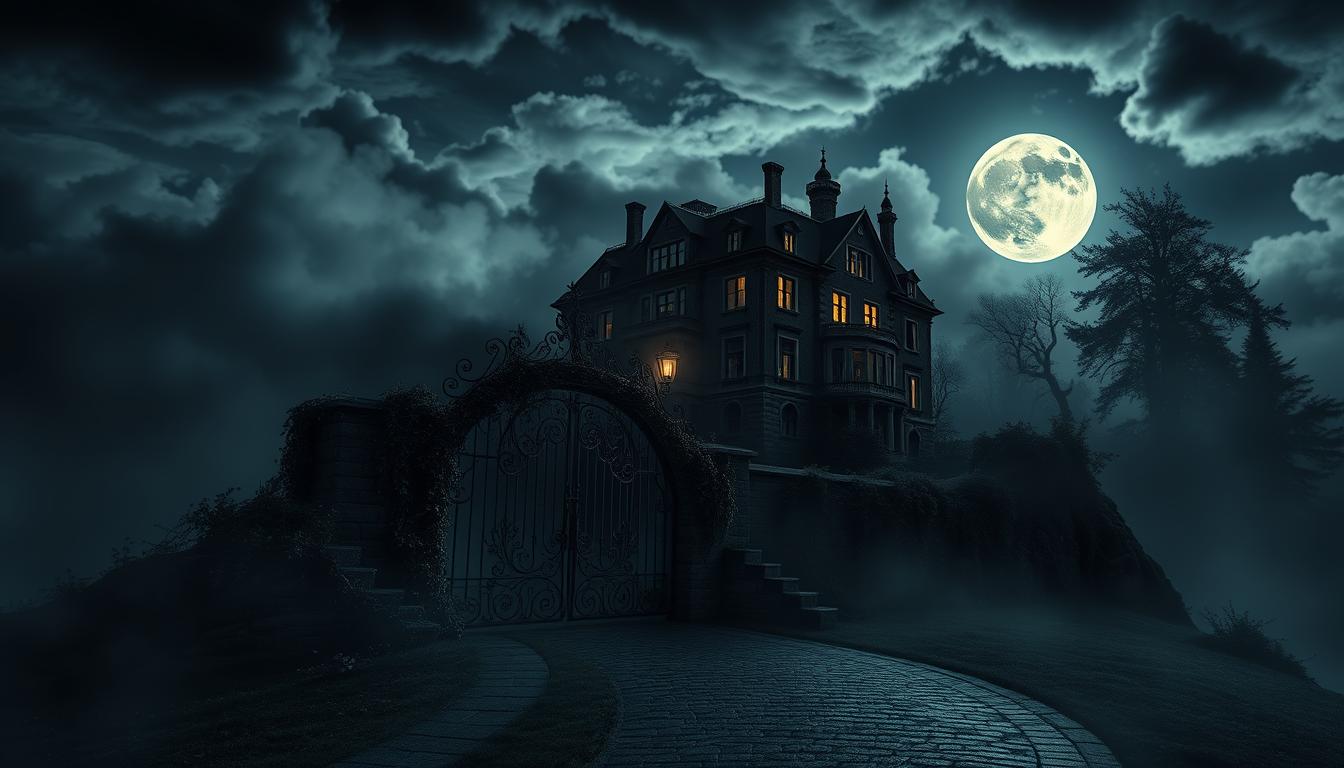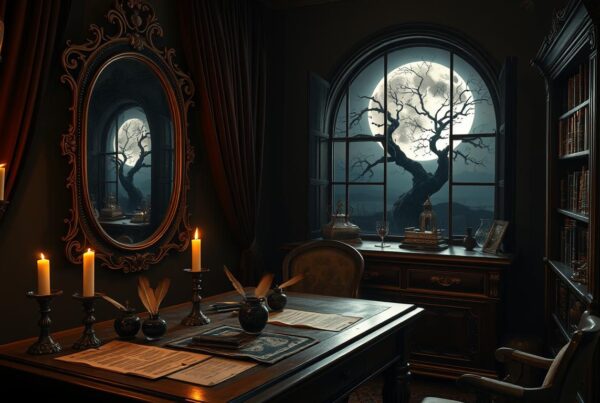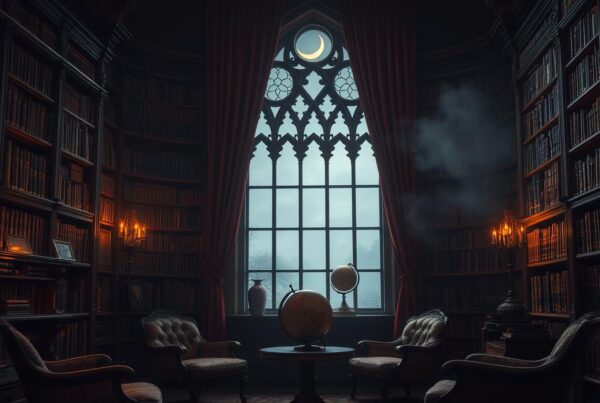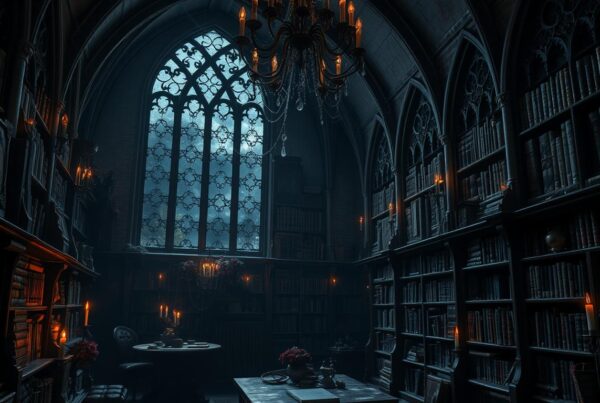Gothic literature has long captivated readers with its dark romance and haunting stories. These tales of mystery and passion have found new life on the silver screen. Filmmakers bring beloved Gothic novels to life.
The journey from page to screen is not without its challenges. Directors strive to capture the eerie atmosphere and complex characters that define this genre.
Film adaptations of Gothic classics allow audiences to experience these timeless stories in a visual medium. From brooding heroes to sinister villains, the world of Gothic romance comes alive. This is through cinematography, set design, and powerful performances.
As we explore the evolution of these adaptations, we’ll uncover how filmmakers have tackled the unique elements. These elements make Gothic literature so enduring and beloved.
The Rise of Gothic Romance in Literature
Gothic romance started in the late 18th century. It mixed horror, mystery, and romance. This made a new kind of story that people loved.
Origins of Gothic Fiction
“The Castle of Otranto” by Horace Walpole started it all in 1764. It had haunted castles and family secrets. This book started a big movement in literature.
Key Elements of Gothic Romance
Gothic romance is known for its spooky feel and deep emotions. Heroes in these stories are often troubled by secrets. They face ghosts and strange events.
These stories often take place in old, lonely places. Like old mansions or foggy moors.
Influential Gothic Romance Authors
Ann Radcliffe was very important in Gothic literature. Her book, “The Mysteries of Udolpho,” helped set the genre’s standards. Mary Shelley’s “Frankenstein” also made a big impact by mixing science with Gothic themes.
These authors helped make Gothic romance a favorite among readers. Their work has lasted for a long time.
Translating Gothic Atmosphere to Film
Bringing Gothic romance to life on screen is a big task. Filmmakers use special camera work to make the atmosphere spooky. They use dark shadows and light to set the mood.
Set design takes viewers to creepy castles and mysterious mansions. Details like cobwebs and candles make the world feel real. These details pull the audience into a world full of suspense.
Mood lighting is key in Gothic films. Dim, warm lights make you feel uneasy. Cool blue lights make things feel cold and scary. Good camera work uses light to show feelings and build tension.
Visual storytelling in Gothic films uses symbols. Things like mirrors and hidden passages show what’s going on inside characters. Filmmakers carefully make each scene to bring the Gothic world to life.
Adaptations of Gothic Romance: From Page to Screen
Gothic romance novels have long captivated readers. They are known for their eerie atmospheres and passionate tales. Moving from page to screen is a big challenge for filmmakers.
They need to find a balance between staying true to the book and making it visually appealing.
Challenges in Adapting Gothic Literature
Turning the rich, atmospheric prose of gothic novels into visuals is hard. Screenwriters must make complex stories simpler while keeping their essence. Directors must create a gothic world that draws the audience in.
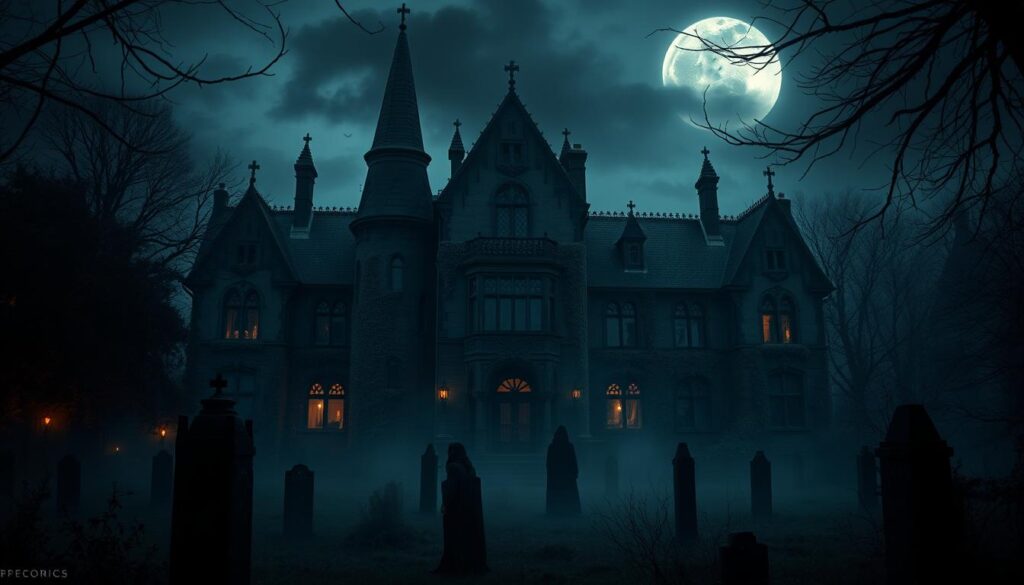
Successful Gothic Romance Adaptations
Some films have captured the essence of gothic romance well. Alfred Hitchcock’s “Rebecca” (1940) is a great example. It brought Daphne du Maurier’s novel to life beautifully.
Guillermo del Toro’s “Crimson Peak” (2015) also shows how modern techniques can update classic gothic themes.
Failed Attempts and Lessons Learned
Not every adaptation succeeds. Some focus too much on looks and forget the story. Others struggle to show the deep emotions of the book.
Good adaptations find a balance between staying true to the book and offering a fresh cinematic view. Filmmakers must think about what the audience wants when bringing these stories to life.
Iconic Gothic Romance Novels and Their Film Versions
Gothic romance novels have been loved for centuries. They have dark stories and passionate love. Many films have brought these stories to life.
Jane Eyre, by Charlotte Brontë, has been made into many films. The 2011 version with Mia Wasikowska and Michael Fassbender is great. It shows Jane’s journey and her love for Mr. Rochester.
Emily Brontë’s Wuthering Heights has also been made into films. The 1939 version with Laurence Olivier is a classic. The 2011 version by Andrea Arnold shows the love story in a raw way.
Bram Stoker’s Dracula has inspired many films. The 1931 version with Bela Lugosi is famous. Francis Ford Coppola’s 1992 film is also well-known for its take on the vampire’s story.
Mary Shelley’s Frankenstein has been seen in many ways on screen. The 1931 film with Boris Karloff is a horror classic. Kenneth Branagh’s 1994 version tried to stay true to the book, exploring big themes.
The Role of Setting in Gothic Romance Adaptations
Setting is key in making Gothic romance come alive on screen. Eerie castles and misty landscapes are perfect for love and mystery stories.
Haunted Castles and Mansions
Gothic architecture is a big part of many adaptations. Towering spires and dark corridors create a haunting atmosphere. Filmmakers use real buildings or detailed sets to capture these structures’ essence.
Atmospheric Landscapes
Mist-shrouded moors and gloomy forests are key in Gothic romance. They make stories feel isolated and foreboding. Directors use lighting and weather to make nature a character.
Period-Specific Details
Historical accuracy is important in Gothic romances. Set designers focus on Victorian era details like furniture and clothes. These details take viewers back in time, making the story feel real.
The mix of Gothic architecture, landscapes, and period details makes a rich visual experience. This focus on setting brings out the passion and mystery of Gothic romance on screen.
Character Archetypes in Gothic Romance Films
Gothic romance films bring classic characters to life. The Byronic hero is a standout. He’s brooding and complex, hiding a dark past and inner demons.
In films, he’s both a love interest and a mystery. This makes him fascinating.
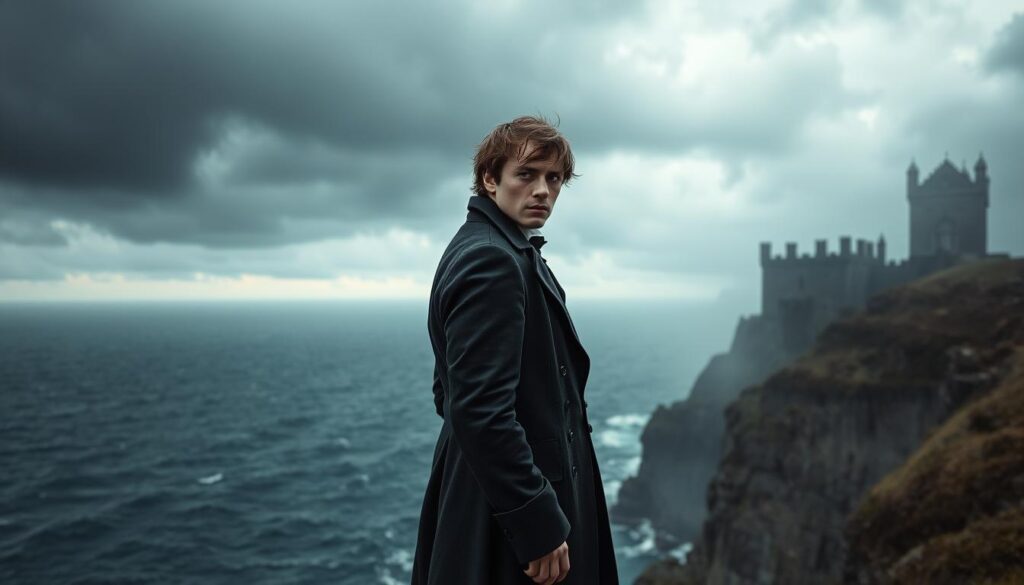
The damsel in distress is another key character. She faces danger and needs rescue. But today’s damsels are different.
They show strength and wit, fighting alongside their saviors. This adds depth to the character.
No Gothic tale is complete without a villainous aristocrat. This character is evil, using wealth and power to harm others. Their grand home is often the setting for evil deeds.
A mysterious stranger adds excitement to the story. They might be a friend or foe, keeping everyone guessing. Their true nature is revealed in key moments.
Modern films mix and change these archetypes. A damsel might become a hero, or a Byronic figure might be the villain. This keeps Gothic romance exciting for today’s viewers.
The Evolution of Gothic Romance in Modern Cinema
Gothic romance in movies has changed a lot. Filmmakers mix old themes with new ideas. This makes neo-Gothic films that grab our attention. It shows the genre’s lasting charm and how it fits into today’s world.
Contemporary Takes on Classic Themes
Today’s Gothic romances update old stories for us. Haunted houses are now smart homes. Old curses show up on social media. These changes make the genre fresh and fun for today’s viewers.
Gothic Romance in Different Genres
Genre-blending has made Gothic romance exciting again. Sci-fi, fantasy, and comedies now have Gothic touches. This mix of genres brings new stories and draws in different fans.
The Influence of Technology on Gothic Storytelling
Digital effects have changed Gothic movies. Filmmakers use new tech to make amazing visuals. Now, we can explore Gothic worlds in virtual reality, feeling like we’re right there.
As tech gets better, Gothic romance keeps changing. It can use new ways to tell stories. From neo-Gothic films to mixing genres, Gothic romance is still exciting and engaging.
Visual Effects and Cinematography in Gothic Romance Films
Gothic romance films grab our attention with their spooky visuals. Filmmakers mix CGI and practical effects to make eerie scenes. CGI makes supernatural things seem real, while practical effects add a touch of reality to the gothic settings.
Chiaroscuro lighting is key in gothic films. It uses strong contrasts to create tension and mystery. Cinematographers shape shadows to hide secrets and show character feelings.
Colors in gothic films also set the mood. Deep reds mean passion and danger, while cool blues show sadness and loneliness. Muted colors show decay, matching the genre’s themes of lost beauty.
Gothic filmmakers use visual effects to take us to another world. They mix old and new techniques for unforgettable movies. This creates a stunning visual world that brings gothic romance stories to life.
Soundtracks and Music in Gothic Romance Adaptations
Music is key in Gothic romance movies. The right soundtrack takes viewers to spooky castles and foggy moors. It makes these dark stories feel real.
Creating Mood Through Music
Composers craft music to make us feel in Gothic films. Strings and melodies make us feel uneasy. Themes for characters add to the story.
Ambient sounds pull us into the Gothic world. It’s like we’re part of it.
Iconic Gothic Romance Film Scores
Some movies have music that sticks with you. The 1992 “Dracula” film has a beautiful score by Wojciech Kilar. It’s romantic and perfect for the movie.
Andrew Lloyd Webber’s “The Phantom of the Opera” is another example. It’s a musical that captures the story’s passion and emotion.
The Role of Silence in Gothic Atmosphere
Silence is as powerful as music in Gothic films. Quiet moments make us wait with bated breath. They let us feel the atmosphere’s weight.
This mix of sound and silence keeps us on the edge of our seats. It makes the Gothic experience even more thrilling.
